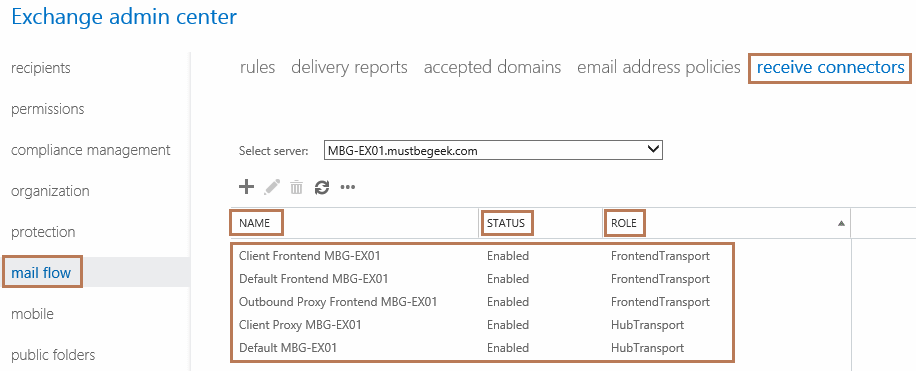Understanding Default Receive Connectors in Exchange 2016
Understanding Default Receive Connectors in Exchange 2016
Exchange 2016 consists of two server roles, Mailbox server role and Edge Transport server role. Mailbox server role has three main transport services (or sub role). These transport services are also called transport pipeline. Emails flow through these pipelines. Three transport services are: –
- Front End Transport service: This service provides stateless service for all incoming and outgoing emails. It doesn’t perform any email queuing or email inspection. When email comes in the Exchange organization, front end transport service is the first point that receives the email. This service sends the email to transport service and does not communicate with mailbox transport service directly.
- Transport service (HubTransport service): Transport service performs queuing and categorization of emails. The service also performs anti-spam and anti-malware inspection. It receives incoming email from front end transport service and forwards to mailbox transport service.
- Mailbox Transport service: It is the mailbox transport service that ultimately stores incoming emails into their respective mailboxes. This service has further two services,
- Mailbox Transport Submission service: – It retrieves message from mailbox database and delivers to transport service to send emails to other recipients.
- Mailbox Transport Delivery service: – It receives emails from transport service and connects to mailbox database using RPC (Remote Procedure Call) and stores them in mailbox database.
To view the list of receive connectors, log on to Exchange Admin Center (EAC), click mail flow in the features pane and select receive connectors tab.
As you can see above there are five receive connectors. There are three FrontendTransport receive connectors and two HubTransport receive connectors. Let’s see what each one of them does,
- Client Frontend MBG-EX01: – This connector accepts secure connections, with Transport Layer Security (TLS) applied. It accepts connections on port 587. This receive connector is used by IMAP and POP clients. This receive connector proxies connection from IMAP and POP applications to HubTransport receive connector called Client Proxy MBG-EX01.
- Default Frontend MBG-EX01: – Emails sent from Internet are received by this transport service on port 25. It then sends those received emails to transport service on HubTransport receive connector called Default MBG-EX01 on port 2525.
- Outbound Proxy Frontend MBG-EX01: – If you have checked proxy through client access server option in Send connector then outgoing emails are received by this connector. In other words, this connector receives emails sent by transport service if proxy through client access server is checked in Send connector as shown below. Frontend transport service now sends the email out on the internet. It receives emails on port 717.

- Client Proxy MBG-EX01: – It is hub transport service. Accepts emails sent from frontend services and sends to mailbox transport service. It accepts connections on port 465. This receive connector accepts proxied POP and IMAP connections sent from front end transport from receive connector called Client Frontend MBG-EX01.
- Default MBG-EX01: – It is hub transport service. It accepts incoming emails from front end transport service and sends to mailbox transport service. Similarly, accepts outgoing emails from mailbox service and uses send connector to send email or sends to receive connector called Outbound Proxy Frontend MBG-EX01 if proxy through client access server option is enabled as talked before. It accepts emails on port 2525.
